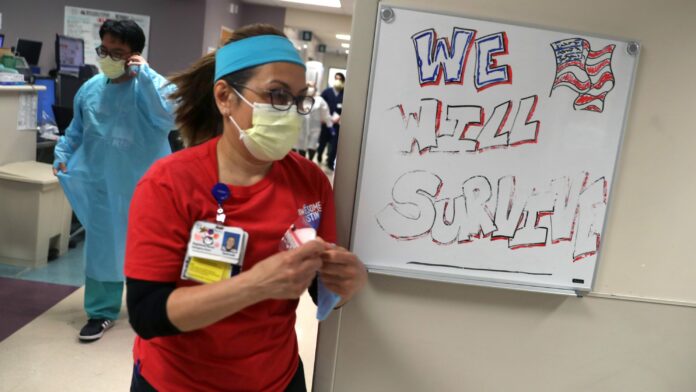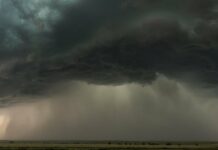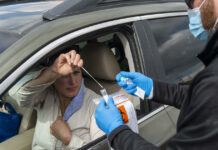CLOSE![]()
Of the confirmed two million coronavirus cases, more than 113,000 Americans have died since the virus emerged here a few months ago.
USA TODAY
It’s been six months since doctors first discovered the coronavirus and the illness it causes, COVID-19.
Since then, the virus has sickened millions of people worldwide, shuttering businesses and tanking economies with no clear end in sight. The United States has seen more than 2 million cases and more than 100,00 deaths.
As cases level and subside in some places and rise in others, the country is beginning a summer reopening. At the same time, nationwide protests sparked by the killing of George Floyd demanding racial justice have brought many Americans out of their homes and onto the nation’s streets.
As more and more people begin moving around, many have renewed questions about SARS-CoV-2:
Will there be a second wave of coronavirus cases? What states are experiencing surges? And when will it be safe to hug my loved ones again?
Here are answers to some of key coronavirus questions.
Are increasing cases in areas of the U.S. part of the ‘second wave’?
This question assumes that the first wave is over. Data suggests that in the U.S. the first wave hasn’t ended, it’s just fluctuated since early April – with an average of 20,000 new confirmed cases every day, as this graph posted to Twitter by Dr. James Hamblin shows. About 1,000 Americans continue to die every day.
“The pandemic isn’t like everyone in the U.S. is on one single shore experiencing a single tsunami wave followed by another one,” said Dr. Yonatan Grad, an assistant professor of immunology and infectious diseases, also at the Harvard T.H. Chan School of Public Health. “The pandemic is made up of many local epidemics, each influenced by local mitigation efforts.”
The virus will continue to spread, he added, as long as there are susceptible people. An estimated 60-70% of the population needs to have become infected and developed immunity to the virus to prevent its spread. New York City, the heaviest hit area of the country, has reached an infection rate of just under 20%.
Experts who track diseases have been making an informal distinction between a “second peak” and a “second wave.”
“We expect there to be second (and third and fourth) peaks in places where physical distancing restrictions are relaxed,” said Stephen Kissler, a mathematician and postdoctoral research fellow in Grad’s lab. “Tightening up restrictions will likely reduce cases again, and then loosening them can make them rise again … basically, as our behavior changes and the epidemic sweeps around the country, we can expect to see multiple peaks of infection.”
A second wave, he said, “usually refers to a major resurgence of cases in the autumn that could strike all parts of the country more or less simultaneously, since viral respiratory pathogens are generally more transmissible in the autumn and winter.” That was the pattern, he said, for flu pandemics in 1918 and 2009. “Transmission remained relatively well under control over the summer, but spiked again in September/October.”
More: US coronavirus map: Tracking the outbreak
This seasonal pattern is what worries Dr. Michael Mina, an assistant professor of epidemiology at Harvard T. H. Chan School of Public Health. Cases of the common cold, which can also be caused by a coronavirus, typically dip this time of year.
“Right now, June, July and August, should be the absolute minimum in terms of when seasonal coronaviruses is usually seen,” he said.
That’s why he’s so concerned that cases are remaining high. If this continues, he said, “we might see a massive burst of cases into the fall. That’s a scary thought.”
Did governors in different states cause the current increases?
While the federal government has attempted to provide guidelines to states throughout the pandemic, the Trump administration largely gave governors authority to decide when and how to reopen.
The White House Coronavirus Task Force issued a three-phase plan aimed at helping states determine when to ease restrictions and allow residents to begin returning to work. But critics were quick to point out the broad guidelines lacked details on how states could achieve some of the benchmarks.
In the meantime, the president encouraged governors to “liberate” their states, and defended people protesting social distancing measures enacted to slow the spread of COVID-19.
A handful of states reopened without meeting task force guidelines, which some experts argue may have led to a spike in cases.
For example, Florida’s reopened restaurants, retail and museums at half capacity as part of its first phase that began May 18. Not only did the state fail to meet a two week decline in cases, but it actually reported an increase in cases per day a week before reopening. According to Johns Hopkins data, Florida reported 594 cases on May 10. Five days later there were more than 800 cases.
About three weeks later, on June 5, Gov. Ron DeSantis’ went on to phase two reopening, even as daily cases have topped the 1,000 mark and have continued to do so for the past seven days.
A record 1,698 cases of COVID-19 were announced Thursday morning by the Florida Department of Health, marking the largest single-day increase in the state since the pandemic began.
However, experts say there’s more than one reason certain states are experiencing a surge in cases. Georgia was one of the first states to reopen in April without meeting guidelines and its curve has stayed relatively flat, said Dr. Jeffrey Shaman, professor of environmental health at Columbia University’s Mailman School of Public Health.
Did the protests fuel more cases?
Public health officials warn new cases of COVID-19 probably will emerge after mass gatherings fueled by the death of George Floyd in Minneapolis and racial unrest in cities across America.
Health experts fear carriers of coronavirus with no symptoms could unwittingly infect others at protests where social distancing is not taking place. The merits of the protesters’ cause “doesn’t prevent them from getting the virus,” said Bradley Pollock, chairman of the Department of Public Health Sciences at the University of California, Davis.
At least one protester in Tampa, Florida, is known to have had COVID-19. However, experts say potential cases need to be monitored over two weeks, the virus’s incubation period, and we won’t know for sure how many cases have amassed from the protests until then.
Protesting – especially without a mask – can put people at higher risk for infection, said Dr. Michael Mina, an assistant professor of epidemiology at Harvard T. H. Chan School of Public Health.
“There’s no doubt in my mind that these can become breeding grounds for this virus,” he said during a media availability. “I would not be surprised to see in the next couple of weeks that we see increases that may be linked to protests.”
Because many of the protesters are younger, he said, it may take a while before a jump in cases can be linked to the social activism. Young adults are less likely to feel ill or be hospitalized by the virus, but they can pass it on to their parents and grandparents, who are more likely to become seriously ill, and therefore show up in the COVID-19 statistics, he said.
“We might still be in a waiting period before we see any transmission,” said Mina.
There is a historical precedent to suggest viruses can be spread by large public gatherings. In September 1918, people in Philadelphia held a parade to support the war bond drive during World War I. The gathering of 200,000 people, crammed shoulder to shoulder, reignited a deadly flu epidemic, leading to massive closures and thousands of deaths, records show.
But there’s also a public health cost to not protesting, said Dr. Hillary Babcock, an infectious disease specialist at the Washington University School of Medicine in St. Louis, and immediate past president of the Society for Healthcare Epidemiology of America.
“Systemic racism also causes large public health impacts and public health risks for large portions of our population,” she said.
How will we know when it’s safe to hug? When will all this be over?
While many hope a vaccine means the end of the pandemic, experts say this is only a milestone in the long journey ahead.
President Trump announced in May a goal to develop 300 million doses of coronavirus vaccine by January, and Dr. Anthony Fauci reinforced that goal in an interview with JAMA editor-in-chief Howard Bauchner at the beginning of the month.
But having vaccine widely available to Americans is only half the battle. Dr. Joel M. Zinberg said in an opinion piece to USA TODAY some people will wait to get vaccinated or won’t get vaccinated at all – similar to the flu vaccine. In recent seasonal influenza seasons, only 45% of the U.S. population was vaccinated.
The coronavirus vaccine may also be more complicated than what people previously thought. Of the more than 100 vaccine candidates in various stages of testing, almost all are expected to be a two-dose regime, said Barry Bloom, an immunologist and professor of public health at the Harvard T.H. Chan School of Public Health in Boston.
The conclusion is that the country will have to live with the virus for a long time and learn live a new normal to reduce the risk of transmission. It will be safer to hug with immunity, but it won’t ever be risk-free.
Contributing: Ken Alltucker USA TODAY
Autoplay
Show Thumbnails
Show Captions
Read or Share this story: https://www.usatoday.com/story/news/health/2020/06/13/coronavirus-q-a-we-second-wave-did-protests-fuel-cases/3174370001/







